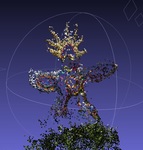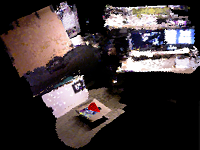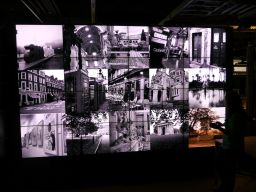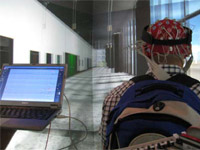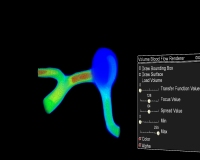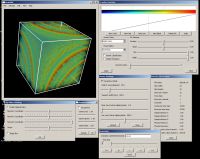Difference between revisions of "Projects"
From Immersive Visualization Lab Wiki
(→OpenAL Audio Server (Shreenidhi Chowkwala, Summer 2011)) |
(→Active Projects) |
||
| Line 2: | Line 2: | ||
=<b>Active Projects</b>= | =<b>Active Projects</b>= | ||
| + | |||
| + | ===[[ArtifactVis]] (Kyle Knabb, Jurgen Schulze, Connor DeFanti, 2008-)=== | ||
| + | <table> | ||
| + | <tr> | ||
| + | <td>[[Image:khirbit.jpg]]</td> | ||
| + | <td>For the past ten years, a joint University of California, San Diego and Department of Antiquities of Jordan research team led by Professor Tom Levy and Dr. Mohammad Najjar has been investigating the role of mining and metallurgy on social evolution from the Neolithic period (ca. 7500 BC) to medieval Islamic times (ca. 12th century AD). Kyle Knabb has been working with the IVL as a master's student under Professor Thomas Levy from the archaeology department. He created a 3D visualization for the StarCAVE which displays several excavation sites in Jordan, along with artifacts found there, and radio carbon dating sites. In a [[Digital Archaeology|related project]] we acquired stereo photography from the excavation site in Jordan.</td> | ||
| + | </tr> | ||
| + | </table> | ||
| + | <hr> | ||
===[[OpenAL Audio Server]] (Shreenidhi Chowkwale, Summer 2011)=== | ===[[OpenAL Audio Server]] (Shreenidhi Chowkwale, Summer 2011)=== | ||
Revision as of 10:07, 19 August 2011
Past Projects
Active Projects
ArtifactVis (Kyle Knabb, Jurgen Schulze, Connor DeFanti, 2008-)
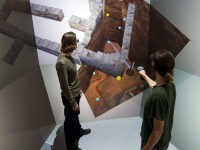 |
For the past ten years, a joint University of California, San Diego and Department of Antiquities of Jordan research team led by Professor Tom Levy and Dr. Mohammad Najjar has been investigating the role of mining and metallurgy on social evolution from the Neolithic period (ca. 7500 BC) to medieval Islamic times (ca. 12th century AD). Kyle Knabb has been working with the IVL as a master's student under Professor Thomas Levy from the archaeology department. He created a 3D visualization for the StarCAVE which displays several excavation sites in Jordan, along with artifacts found there, and radio carbon dating sites. In a related project we acquired stereo photography from the excavation site in Jordan. |
OpenAL Audio Server (Shreenidhi Chowkwale, Summer 2011)
 |
description missing |
GreenLight BlackBox 2.0 (John Mangan, Summer 2011)
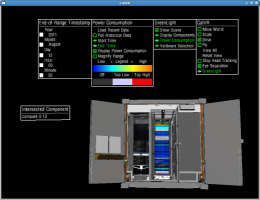 |
Visualization for CalVR of the BlackBox along with all internal components/servers, including power consumption and temperature reading modes. |
3D Reconstruction of Photographs (Matthew Religioso, 2011-)
Real-Time Geometry Scanning System (Daniel Tenedorio, 2011-)
Real-Time Meshing of Dynamic Point Clouds (Robert Pardridge, James Lue, 2011-)
LSystems (Sarah Larsen 2011-)
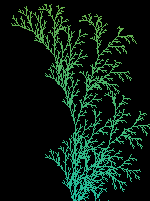 |
Creates an LSystem and displays it with either line or cylinder connections |
Android Controller (Jeanne Wang 2011-)
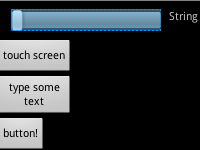 |
An Android based controller for a visualization system such as StarCave or a multiscreen grid. |
Object-Oriented Interaction with Large High Resolution Displays (Lynn Nguyen 2011-)
ScreenMultiViewer (John Mangan, Phi Hung Nguyen 2010-2011)
 |
A display mode within CalVR that allows two users to simultaneously use head trackers within either the StarCAVE or Nexcave, with minimal immersion loss. |
MatEdit (Khanh Luc, 2011)
Kinect UI for 3D Pacman (Tony Lu, 2011)
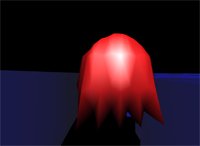 |
An experimentation with the Kinect to implement a device free, gesture controlled user interface in the StarCAVE to run a 3D Pacman game. |
TelePresence (Seth Rotkin, Mabel Zhang, 2010-)
CaveCAD (Lelin Zhang 2009-)
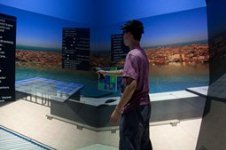 |
Calit2 researcher Lelin ZHANG provides architect designers with pure immersive 3D experience in virtual reality environment of StarCAVE. |
GreenLight Blackbox (Mabel Zhang, Andrew Prudhomme, Seth Rotkin, Philip Weber, Grant van Horn, Connor Worley, Quan Le, Hesler Rodriguez, 2008-)
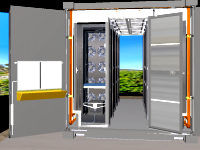 |
We created a 3D model of the SUN Mobile Data Center which is a core component of the instrument procured by the GreenLight project. We added an on-line connection to the physical container to display the output of the power modules. The project was demonstrated at SIGGRAPH, ISC, and Supercomputing. |
